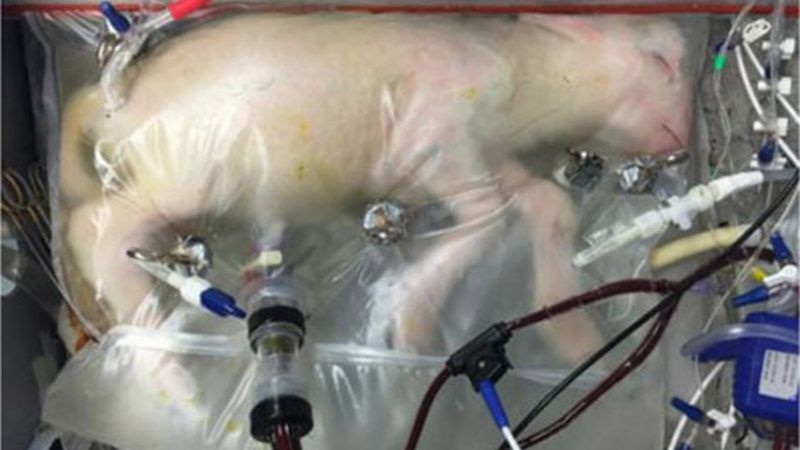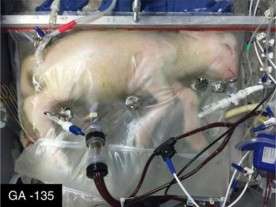Giant Ziplock Baggies Full of Lambs Are Going to Change Everything


In April, researchers announced they had managed to keep several extremely premature lambs alive and growing in artificial wombs. After spending up to four weeks in a clear plastic "extra-uterine device" at the Children's Hospital of Philadelphia, each sheep transformed from a decidedly undercooked fetal specimen to a much more robust critter with long limbs and a fluffy wool coat, the sort of animal you wouldn't be terribly alarmed to see plop to the ground in a field on a spring afternoon.
The setup strongly resembles a sous vide cooking apparatus: a tiny, tender lamb floats in a large plastic ziplock, hooked up to tubes and monitors. But a video clip posted by the researchers has the emotional heft of feeling a fetus kick when you put a hand on a pregnant woman's belly. Visible through the clear plastic, the lamb's hooves twitch gently as it snuffles its nose and wiggles its ears.
The lambs in the experiment were selected for their developmental similarity to human babies born right on the edge of viability, or about four months premature. Babies born that early are equal parts horrifying and marvelous. Tiny creatures with organs visible through their translucent skin, they're often called "miracle babies." But there's nothing particularly mysterious about those little beings curled up in nests of tubes and wires; they live because of the inspiration and hard work and risk-taking and study and pain of hundreds of people.
There are actually more of these struggling newborns now than there were a decade ago, simply because we've gotten so much better at keeping extremely premature babies—born before 24 gestational weeks—alive. Yet in the U.S., one-third of all infant deaths and one-half of all cases of cerebral palsy are still attributed to prematurity. Of the babies born that early who survive, more than 90 percent have severe and lasting health consequences, especially with their lungs, eyes, and intestines.
Previous efforts to improve those numbers have been stymied by difficulties duplicating the functions of the placenta, but the device attached to the "Biobag" looks deceptively simple: a pumpless blue plastic box hooked up to the umbilical cord that oxygenates the blood, removes carbon dioxide, and adds nutrients.
In their paper, published in Nature Communications, the Philadelphia researchers are careful to say that human applications of their work are at least a decade away. Yet these little pink lambs are already taking sledgehammers to some of the most precarious coalitions in American politics.
Because as petty as our politics can seem, many of our fiercest debates rest on questions of birth, death, and our obligations to the not-quite and just-barely born.
The implications for the abortion debate are obvious. (I've probably already annoyed you with my use of baby or fetus in the passages above, no matter which side you're on.) Pro-life and pro-choice forces have reached tense legal stasis around the threshold of viability, but a true artificial womb tech could render the term meaningless. Gestation in a plastic bag makes the reality of prenatal humanity more immediate, but also removes the remaining aura of naturalness and inevitability from the process.
There exists an uneasy coalition between certain feminists and certain conservatives who oppose gestational surrogacy—the closest current analogue to an artificial womb, in which a woman carries a fertilized egg to term. (The embryo is typically created through in vitro fertilization and is often not genetically related to the surrogate.) But when the borrowed womb is a baggie—not a poor woman at risk for exploitation—the moral and political calculus changes. Perhaps this innovation will bring some wandering feminists back over to the side of reproductive tech.
Those worried about state coercion will fret about the possibility of artificial wombs becoming mandatory, with governments requiring artificial support of unwanted fetuses in lieu of abortion.
Meanwhile, folks more concerned about Big Business than Big Brother will wonder if corporations could make external gestation a condition of employment, to reduce working hours lost on maternity leave and pregnancy complications.
And let's not even talk about the question of who is going to pay for all these baggie babies.
Egalitarians will see the latest advance as more self-indulgence by decadent rich countries. They will note that in the developed world, half of the babies born four months early do at least survive already, whereas in poor countries those born just two months premature are in the same 50–50 survival territory. The expensive cutting-edge science going to keep super-preemie Americans alive is a far cry from the lack of warmth, feeding, or basic care for infections that dooms babies unlucky enough to be born elsewhere.
Alan Flake, a fetal surgeon at the Children's Hospital of Philadelphia and one of the authors of the lamb study, cautions that completely outsourcing human gestation is still "science fiction." He told NPR his goal is not to push back the threshold of viability. "I want to make this very clear: We have no intention and we've never had any intention with this technology of extending the limits of viability further back," he said, calling such a project "a pipe dream."
Leaving aside the question of whether the good doctor is dissembling here—it's hard to believe no one in his lab has such ambitions—his effort to draw a bright line reveals just how impossible that will be.
In actual practice, we will slip across the line from amelioration to augmentation almost silently. Doctors will treat the no-hopers first—the desperate preemie, the terminal case—but such tech calls out to imagination and commercialization.
After all, even babies who make it to the full 40 weeks are barely ready to survive on the outside. There's an entire cottage industry of parenting advice books that suggest treating the first three months of your baby's life as an unofficial "fourth trimester."
Explanations for why human babies are born so utterly incompetent vary. One long-held theory, known as the "obstetrical dilemma," posits an arms race between big brains and small pelvises. A more recent theory suggests that the limiting factor is actually maternal metabolism: The body's ability to produce enough energy for two human lives simply maxes out at about nine months. This technology could eliminate both of those concerns down the line. Babies really could spend their fourth trimester in utero.
Crunchy moms already give birth in wading pools, on the theory that that's an easier transition for the newborn. Why not let Junior slide smoothly into a nice warm baggie of amniotic fluid instead? At the other end of the spectrum, what about the busy technophile who wants to voluntarily pluck her beloved parasite out as soon as possible, outsourcing those final bloated, painful months to a squadron of attentive medical techs?
Flake is right about one thing when it comes to pushing the limits of viability: "I think when you do that you open a whole new can of worms."
But we already live in a world of "science fiction" and "pipe dreams." The power to save and create new categories of life may rejigger our politics in the short term. But in the long term, one more marvel will fit in just fine.
This article originally appeared in print under the headline "Giant Ziplock Baggies Full of Lambs Are Going to Change Everything."




Show Comments (187)